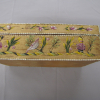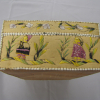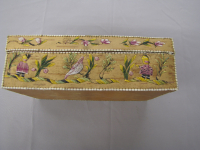case
case
case








Colourful moosehair embroidered birch bark box with matching lid that appeared in the Paris World's Fair/Exposition Universelle of 1878. Embroidered with scenes of daily life, with three figures in a canoe, men and women walking, smoking pipes, holding gourds, and a scene of a campfire with a pot over it. Dates from the second half of the nineteenth century and was probably made as part of the souvenir arts production of the Huron-Wendat community of Wendake (Lorette) in Quebec.
In the nineteenth century, the Huron-Wendat community of Wendake (Lorette) was well known for moosehair embroidered souvenir arts.
MQB catalogue and archives, stylistic analysis.
deStecher, Annette. Engaged Histories: Wendat Women’s Souvenir Artsof Cultural Preservation and Entrepreneurial Invention. PhD dissertation. Ottawa: Carleton University, 2013.
Read More About This Relative
Birch bark, dyed moosehair using aniline dyes: purple, yellow, green, brown/black, shades of light brown; brown cotton thread.
Satin stitch with edging of white moosehair, bound with brown cotton thread. The edging does not have the basket weave motif along the edging, which is usually seen in Huron-Wendat work.
The box is embroidered with scenes of daily life, characteristic of Huron-Wendat souvenir bark work. There is a scene of three figures in a canoe, with what looks like feathers in their hair; There is a border of leaves and flowers framing the scene. On the sides are scenes of men and women walking, smoking pipes, holding gourds, and a scene of a campfire with a pot over it.
A large bird is in the center of both long sides, its large size in proportion to the people is characteristic of Wendat work.-AD.
The number 9983 is stamped in ink on the underside. Another number is on the inside: 78.40.21.
Aniline dye, which came into use after 1858, was used to colour the moosehair embroidery on this case, making 1858 the earliest possible date. The box appeared in the Paris World's Fair of 1878, making this the latest possible date of manufacture.
Provenance
This box was in the Paris World Fair or Exposition Universelle of 1878 and was donated by the Canadian Commission. It was formerly in the collection of the Musée de l’Homme (Amérique) and is now in the Musée du quai Branly.A.deS.
About This GRASAC Record
Unknown artist, case. Currently in the Musée du quai Branly, 71.1878.40.2.1-2. Item photographed and described as part of a GRASAC research trip; GRASAC item id 1373.
This record was created by Anne de Stecher during an RAship for Prof. Ruth Phillips, from fieldtrip research conducted through a SSHRC award.
Limited access until the completion of Anne de Stecher's dissertation research, 2011.
46.869279102, -71.347896113
Material similar to this is known to have been made by the Huron-Wendat community of Wendake (Lorette), a nation of the Easter Great Lakes.
 Knowledge Sharing Platform
Knowledge Sharing Platform







